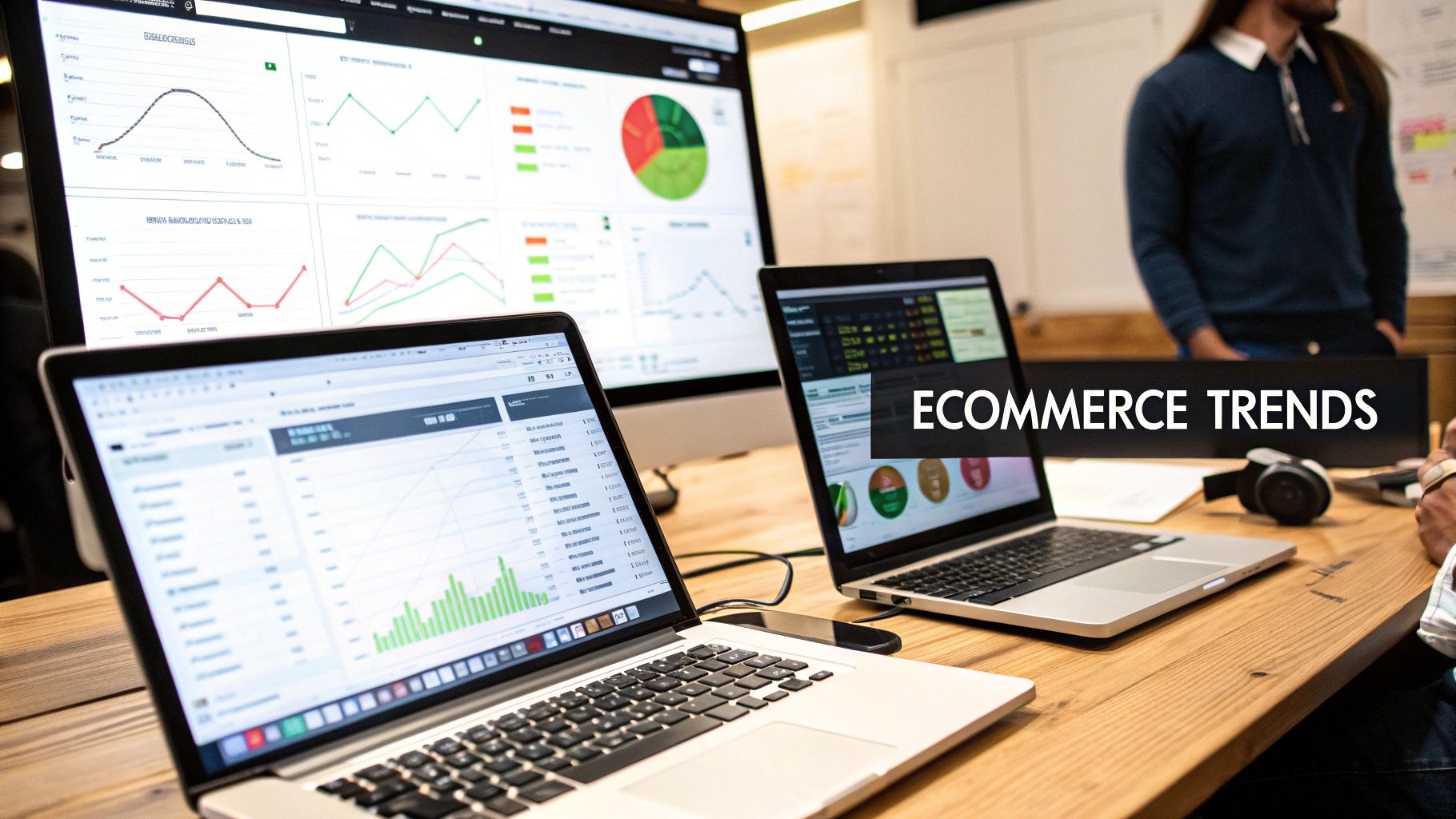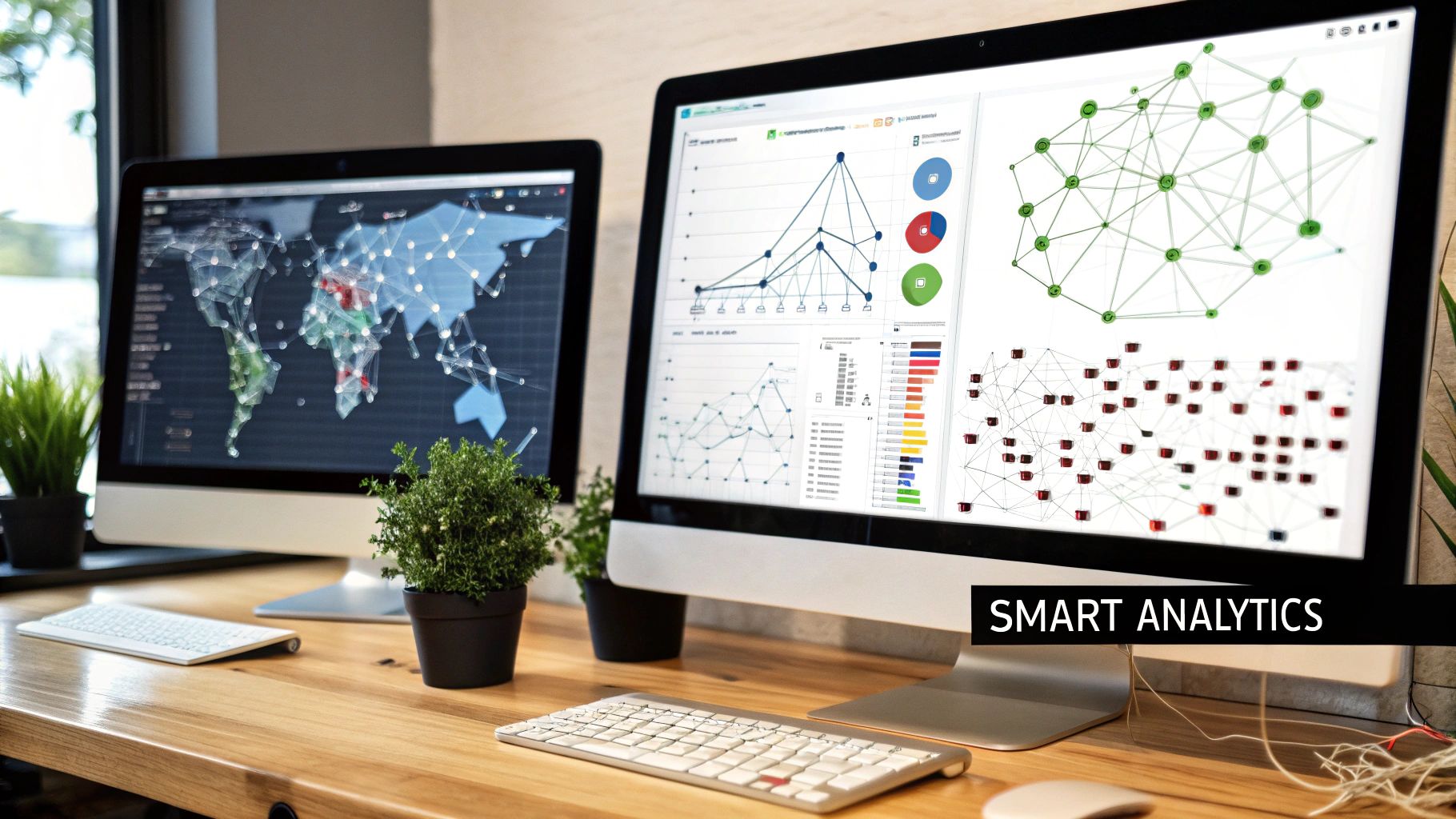Unlocking the Power of Predictive Analytics in Ecommerce

Predictive analytics in ecommerce is no longer a futuristic concept. It's a core component of how successful online businesses operate. This data-driven approach anticipates future trends and customer behaviors, empowering businesses to make proactive decisions. Instead of simply reacting to past sales data, predictive analytics allows you to anticipate and capitalize on future opportunities.
Imagine accurately predicting next month's high-demand products. This foresight allows you to optimize inventory levels, preventing costly stockouts and ensuring you meet customer demand. This practical application highlights the real-world potential of predictive analytics.
Predictive analytics is transforming the ecommerce landscape, enhancing customer experiences, and driving sales growth. In the UK, businesses like iWeb are leveraging predictive analytics to personalize the shopping journey. Platforms like Adobe Commerce use these techniques to offer tailored product recommendations. This personalized approach not only enhances the customer experience but also increases conversion rates.
Personalized experiences foster customer satisfaction and loyalty—a crucial ingredient for sustained success in ecommerce. Analyzing past behaviors and preferences enables businesses to anticipate customer needs and tailor their offerings accordingly. The result? Higher customer engagement and retention rates, ultimately contributing to substantial growth in the UK ecommerce market. Explore this topic further here.
How Predictive Analytics Works in Ecommerce
Predictive analytics uses historical data, statistical algorithms, and machine learning to identify patterns and predict future outcomes. This complex process involves several key steps:
- Data Collection: Gathering data from various sources, including website traffic, purchase history, customer demographics, and marketing campaign performance.
- Data Cleaning and Preparation: Ensuring data accuracy and consistency by identifying and removing errors and inconsistencies. This crucial step prepares the data for effective analysis.
- Model Building: Developing predictive models using sophisticated statistical techniques and machine learning algorithms. These models are the engine of predictive analytics.
- Model Validation and Deployment: Rigorously testing the accuracy of the developed model and integrating it into the business's operational systems.
- Monitoring and Optimization: Continuously evaluating and adjusting the model's performance to maintain accuracy and adapt to evolving trends.
These models predict various critical business aspects, including customer behavior, product demand, and market trends. This valuable information empowers businesses to make informed decisions regarding inventory management, marketing strategies, and pricing optimization.
Benefits of Predictive Analytics in Ecommerce
Integrating predictive analytics into your ecommerce strategy offers numerous advantages that can significantly impact your bottom line:
- Increased Sales: Identifying potential customers and their preferences allows for personalized marketing campaigns and product recommendations, leading to higher conversion rates.
- Improved Customer Retention: Anticipating customer needs allows for proactive customer service and personalized offers, strengthening customer loyalty and reducing churn.
- Optimized Inventory Management: Forecasting demand accurately enables you to maintain optimal stock levels, minimizing storage costs and preventing stockouts.
- Enhanced Pricing Strategies: Predictive models help determine optimal pricing by considering factors like demand, competition, and customer behavior, maximizing revenue and profitability.
- Data-Driven Decision Making: Shifting from intuition to data-backed insights empowers you to make more informed and strategic business decisions.
By understanding and implementing these strategies, businesses can gain a substantial competitive advantage in the dynamic world of ecommerce.
The Evolution: From Basic Stats to AI-Powered Insights

Today's predictive analytics solutions in ecommerce are a significant advancement from earlier methods. Understanding this evolution is key to appreciating the power of modern tools. Initially, ecommerce businesses relied on basic statistical models, focusing primarily on past sales data. These models could identify trends, such as seasonal sales increases, but lacked the ability to predict individual customer behavior. It was like predicting the average temperature for the month—helpful information, but not specific enough for daily planning.
The growth of the internet dramatically impacted ecommerce. Between 1996 and the end of 1997, internet users grew from less than 40 million to over 100 million. This surge fueled a corresponding rise in online sales. Companies like Amazon saw revenue jump from under $16 million to $148 million during that same period. This rapid expansion created a need for more sophisticated tools to understand customer behavior and optimize inventory. For more detailed statistics, see this report on the emerging digital economy.
The Rise of Machine Learning
The next major advancement involved incorporating machine learning algorithms. This allowed businesses to analyze larger, more complex datasets, including website traffic, customer demographics, and product interactions. These algorithms could identify intricate patterns and begin predicting individual customer preferences. It was like upgrading from predicting monthly temperatures to forecasting daily highs and lows—a more granular level of detail.
Early machine learning models, however, still faced challenges. Data quality issues and limited computing power often hindered their accuracy and scalability. Inaccurate or incomplete customer data, for example, could lead to skewed predictions and ineffective personalization. This period highlighted the importance of robust data infrastructure and cleaning processes.
The AI-Powered Present
Now, AI-driven predictive analytics tools offer a significant advantage for ecommerce businesses. These tools process massive amounts of data in real-time, providing deeper insights into customer behavior and market trends. Advanced algorithms can anticipate individual needs, optimize pricing dynamically, and even automate inventory management and supply chain operations. It's like having a personalized forecast that not only predicts the temperature but also suggests your ideal outfit.
This AI-powered era is also marked by increased accessibility. Sophisticated predictive analytics tools, once only available to large enterprises, are now accessible to businesses of all sizes. This has leveled the playing field, empowering small and medium-sized businesses to use predictive analytics for growth and increased competitiveness. As ecommerce continues to develop, predictive analytics will become increasingly essential for businesses seeking to thrive.
Transforming Customer Experiences That Drive Conversion

Predictive analytics in ecommerce is revolutionizing the customer journey. It's about creating personalized experiences at every touchpoint, anticipating customer needs before they even arise. This proactive approach is significantly impacting how businesses interact with their customers and driving impressive results.
Personalized Product Discovery
Predictive analytics shines in product discovery. Instead of generic product listings, customers are presented with dynamic product recommendations based on their individual preferences and past behavior. This creates a unique storefront for each shopper, increasing the likelihood of finding the perfect product.
For example, a customer who frequently browses running shoes will see personalized deals on similar products and new arrivals. This tailored experience boosts engagement and encourages purchases.
Individualized Pricing Strategies
Individualized pricing is another powerful application of predictive analytics. By analyzing purchase history, browsing patterns, and real-time market data, businesses can optimize pricing for each customer. This doesn't always mean charging different prices for the same product. It often involves offering personalized discounts and promotions based on individual buying intent.
This targeted approach incentivizes conversions and maximizes profitability.
Reducing Cart Abandonment
Cart abandonment is a common ecommerce challenge. Predictive analytics offers solutions by identifying the causes of abandonment and triggering timely interventions. For example, if a customer abandons their cart due to high shipping costs, a personalized discount or free shipping offer can be automatically applied.
This proactive approach can significantly recover lost sales and reduce cart abandonment rates.
Anticipating Customer Needs
Leading ecommerce businesses are leveraging behavioral analysis to anticipate customer needs. This can involve suggesting complementary products, offering proactive customer support, or predicting future purchases based on past behavior. This shifts the customer experience from reactive to proactive.
Imagine a customer who regularly buys coffee beans receiving a reorder reminder just as their supply dwindles – a simple yet effective example of predictive analytics at work.
Balancing Personalization and Privacy
While personalization is key, maintaining customer trust is paramount. Responsible data usage and transparency about data collection practices are essential. Giving customers control over their data and providing clear opt-out options builds trust. This ensures personalization doesn't compromise privacy, fostering a positive shopping experience.
To demonstrate the impact of predictive analytics, let's examine some key customer metrics:
The following table compares key customer-related metrics before and after implementing predictive analytics solutions. It highlights the average improvement observed across various ecommerce sectors.
| Metric | Without Predictive Analytics | With Predictive Analytics | Average Improvement |
|---|---|---|---|
| Conversion Rate | 2% | 4% | 100% |
| Average Order Value | $50 | $60 | 20% |
| Customer Lifetime Value | $200 | $300 | 50% |
| Cart Abandonment Rate | 20% | 10% | 50% |
| Customer Retention Rate | 30% | 40% | 33% |
As the table illustrates, predictive analytics has a significant positive impact on key customer metrics across various ecommerce sectors. From increased conversion rates and average order value to improved customer lifetime value and retention, the data underscores the effectiveness of these solutions. By leveraging these insights, businesses can optimize their strategies and drive substantial growth.
Optimizing Inventory and Supply Chain Performance

While personalized customer experiences are often front and center in the world of ecommerce, optimizing behind-the-scenes operations like inventory management and supply chain efficiency can yield significant returns. Predictive analytics offers a powerful toolkit for achieving these improvements. Let's explore how industry leaders leverage these advanced forecasting techniques.
Balancing Inventory Levels: Reducing Overstock and Preventing Stockouts
Maintaining optimal inventory levels is crucial. Excess inventory ties up valuable capital and increases the risk of product obsolescence. On the other hand, insufficient inventory leads to stockouts, resulting in lost sales and frustrated customers. Predictive analytics offers a data-driven solution.
By accurately forecasting demand, businesses can fine-tune their inventory levels. This minimizes the risk of both overstocking and stockouts. The result? Improved sales potential and reduced storage costs. The right products are available at the right time, leading to a more efficient and profitable operation.
Forecasting Demand with Advanced Models
Predictive models go beyond simply analyzing historical sales data. They incorporate a range of factors, including seasonality, emerging trends, and even external influences like weather patterns or economic indicators.
For example, a clothing retailer can anticipate the increased demand for winter coats during colder months. These models also allow businesses to react to sudden shifts in demand, such as a trending product, allowing them to capitalize on these opportunities. This detailed approach leads to more accurate predictions, optimizing purchasing decisions and overall inventory management.
Predictive Maintenance for Fulfillment Systems
Predictive analytics also plays a key role in predictive maintenance. By analyzing data from warehouse equipment, potential maintenance needs can be identified before they cause disruptions. Imagine predicting when a conveyor belt is likely to fail and scheduling preventative maintenance accordingly.
This proactive approach minimizes unexpected downtime, ensuring smooth and efficient fulfillment operations. Preventing equipment failures before they occur keeps orders flowing and customers satisfied.
Anticipating Shipping Delays and Supply Disruptions
Shipping delays are a common source of customer dissatisfaction. Predictive analytics can help anticipate potential delays by analyzing real-time data on weather, traffic, and carrier performance. This allows for proactive communication with customers, managing expectations and minimizing negative feedback.
Furthermore, predictive models can analyze data from various sources, including news reports and social media, to identify potential supply chain disruptions. Early identification provides valuable time to develop contingency plans and mitigate any negative impact, contributing to a more resilient supply chain.
Real-World Examples of Supply Chain Optimization
Many companies are already reaping the benefits of predictive analytics in their supply chain. Large online retailers use these models to optimize their warehousing networks, strategically positioning inventory closer to customers to reduce shipping times and costs.
Food delivery services, for example, leverage predictive analytics to optimize delivery routes, improving driver efficiency and minimizing delivery times. These real-world applications highlight the tangible benefits, from increased efficiency and reduced costs to enhanced customer satisfaction.
Implementing Predictive Analytics: Your Practical Roadmap
Moving from theory to practice, this section offers a realistic implementation pathway for predictive analytics in ecommerce, regardless of your current data maturity. Whether you're just starting out or ready for advanced applications, this roadmap will guide you.
Assessing Your Data Maturity
The first step is honestly assessing your current data capabilities. Where does your business stand in its analytics journey?
- Beginner: You're primarily collecting basic sales data and website traffic information. Your focus should be on establishing robust data collection processes and improving data quality.
- Intermediate: You're collecting data from multiple sources and beginning to use basic analytics tools like Google Analytics. Your next step is exploring more advanced analytics techniques and integrating data sources for a holistic view.
- Advanced: You have a strong data infrastructure and are using advanced analytics tools. Your focus should be on leveraging AI-powered predictive models and exploring new applications.
Understanding your current stage helps determine the appropriate tools and resources for a successful implementation.
Selecting the Right Predictive Tools
Choosing the right predictive analytics tools is crucial. Several factors should guide your selection:
- Business Needs: Identify your specific business challenges and choose tools that address those needs. Are you focused on optimizing inventory, personalizing recommendations, or enhancing pricing strategies?
- Data Compatibility: Ensure the tools integrate seamlessly with your existing data infrastructure. Data compatibility is essential for accurate and effective analysis.
- Budget and Resources: Balance functionality with affordability. Explore options ranging from open-source solutions like R to enterprise-grade platforms.
- Ease of Use: Choose user-friendly tools that empower your team to effectively leverage the insights. Usability can significantly impact the successful adoption of new tools.
Choosing the right tools ensures you gain actionable insights and maximize your return on investment.
Building Your Analytics Team and Establishing Governance
Implementing predictive analytics in ecommerce requires a skilled team and robust data governance. Let's explore both.
Building Your Analytics Team
Two primary options exist for building your team:
- Build an In-House Team: Develop internal expertise by hiring data scientists and analysts. This offers greater control but requires a significant investment.
- Outsource to Experts: Engage external consultants or specialized agencies. This provides immediate expertise but may offer less control over the process.
Choosing the right approach depends on your budget, long-term goals, and internal resources.
Establishing Data Governance Frameworks
Data governance is critical, particularly with growing privacy concerns. Implementing clear policies and procedures for data collection, storage, and usage builds customer trust and protects your business. Key aspects include:
- Transparency: Be upfront with customers about how their data is being used. Transparency builds trust and strengthens customer relationships.
- Data Security: Implement robust security measures to protect customer data. Data breaches can severely damage your reputation.
- Compliance: Adhere to relevant data privacy regulations like GDPR. Compliance is not only ethical but essential for avoiding legal issues.
Responsible data handling is crucial for maintaining a positive brand image and building customer loyalty.
Implementing and Measuring Success
Implementing predictive analytics is most effective when approached strategically. We'll explore a phased approach and how to define objectives.
Phased Implementation for Incremental Value
A phased approach is recommended. Start with a pilot project focused on a specific area, such as inventory optimization or personalized recommendations. This allows you to test and refine your approach before scaling across the entire business. Measure the results of each phase and use those insights to inform subsequent implementations. This mitigates risk and delivers tangible value at each stage.
To better illustrate different approaches, consider the following comparison:
To understand the different ways to implement predictive analytics, the following table provides a comparison of various implementation strategies, tailored for ecommerce businesses of different sizes. It highlights key considerations like resource requirements and expected ROI.
Predictive Analytics Implementation Comparison
| Implementation Approach | Suitable Business Size | Resource Requirements | Timeline | Expected ROI |
|---|---|---|---|---|
| Basic in-house analysis with existing tools (e.g., Excel, Google Analytics) | Small to Medium | Minimal, primarily staff time for analysis | Short (weeks to months) | Low to moderate |
| Leveraging pre-built solutions from ecommerce platforms (e.g., Shopify analytics, Amazon Forecast) | Small to Large | Low, primarily subscription fees and some setup time | Short to Medium (weeks to months) | Moderate |
| Custom model development with external consultants or specialized agencies | Medium to Large | Moderate to High, including consultant fees, data preparation, and integration costs | Medium to Long (months) | High, dependent on project scope and success |
| Building a dedicated in-house data science team | Large | High, including salaries, infrastructure, and software costs | Long (months to years) | Potentially very high, requires long-term strategy and ongoing investment |
This table provides a starting point for considering which implementation strategy best suits your needs and resources.
Securing Stakeholder Buy-In
Securing stakeholder buy-in is essential. Communicate the benefits of predictive analytics clearly and demonstrate the potential return on investment. Use data and case studies to illustrate the value and address any concerns. This ensures alignment and support throughout the implementation.
Setting Measurable Objectives
Define clear, measurable objectives aligned with your overall business goals. Whether it’s increasing conversion rates, reducing customer churn, or optimizing inventory levels, having specific targets allows for measuring success. Track your progress regularly and adjust your strategy as needed to achieve your desired outcomes. This ensures that your predictive analytics investments contribute directly to your bottom line.
Future-Proofing Your Predictive Analytics Strategy
The ecommerce world is constantly changing. To stay competitive, businesses need to distinguish passing fads from lasting trends. This section explores key developments in predictive analytics for ecommerce, including advances in machine learning, the Internet of Things (IoT), and the rise of automated decision-making.
Emerging Data Streams: Voice, Visual Search, and Augmented Reality
New technologies are creating valuable data streams for predictive models. Voice commerce and visual search, for example, offer rich insights into customer preferences and buying habits. Integrating these data points into predictive models leads to more accurate forecasting and personalized product recommendations.
Augmented reality (AR) experiences are another emerging source of valuable data. Consider a customer using AR to virtually "try on" clothing or see how furniture would look in their home. This interaction generates data that can inform product development, inventory management, and targeted marketing campaigns.
Navigating the Changing Data Privacy Landscape
Data privacy regulations, such as GDPR and CCPA, are transforming how businesses collect and use customer data. It's critical to build adaptable predictive systems that comply with these evolving rules. This means prioritizing data security, transparency, and giving customers control over their own information.
Flexible systems are essential for navigating the complex regulatory environment. Investing in adaptable platforms ensures your predictive analytics strategy remains effective while respecting customer privacy. This builds trust and protects your brand's reputation.
Machine Learning Advancements and Autonomous Decision Systems
Advances in machine learning algorithms are increasing the accuracy and complexity of predictive models. These improvements help businesses extract deeper insights from their data, uncover subtle patterns, and make more informed predictions.
Autonomous decision systems are increasingly used for tasks like dynamic pricing and inventory optimization. These AI-powered systems analyze data, identify the best strategies, and implement decisions in real time. While human oversight is still important, these automated systems improve efficiency and responsiveness to market fluctuations.
Prioritizing Innovation Investments: Hype vs. Reality
Not every emerging technology delivers on its promise. Some represent real opportunities, while others remain speculative. Understanding this difference is crucial for making smart investment choices.
For example, while certain AI applications, like machine learning for personalized recommendations, are already producing tangible benefits, other applications, such as the widespread adoption of autonomous robots in warehouses, are still developing. Focusing on proven technologies with practical uses will maximize your ROI.
The following table categorizes emerging technologies by their current maturity and potential impact:
| Technology | Maturity Level | Potential Impact |
|---|---|---|
| Machine Learning for Personalization | High | High |
| IoT for Real-time Inventory Tracking | Medium | High |
| Autonomous Decision Systems for Pricing | Medium | Medium |
| AR/VR for Enhanced Customer Experience | Medium | Medium |
| Blockchain for Supply Chain Transparency | Low | High |
This framework helps you separate immediate opportunities from long-term prospects, guiding your investment decisions and allowing you to strategically prioritize innovation within your predictive analytics strategy. By focusing on proven technologies, you can effectively future-proof your ecommerce business and gain a competitive advantage.
Measuring Success: Beyond Basic Metrics
Implementing predictive analytics in ecommerce requires a deep understanding of performance measurement. It's not enough to simply track website traffic. You need a comprehensive framework that justifies the investment in these technologies and guides ongoing optimization. This section explores practical ways to measure return on investment (ROI) across various ecommerce applications.
Direct Financial Impacts
The most straightforward way to measure the success of predictive analytics is to assess its impact on your bottom line. This involves tracking key metrics:
- Increased Conversion Rates: Are more website visitors completing purchases after implementing predictive analytics? Higher conversion rates translate directly into more revenue.
- Higher Average Order Values: Are customers adding more items to their carts or choosing more expensive products because of personalized recommendations? An increase in average order value shows that predictive analytics is influencing purchase decisions.
For example, a 5% increase in conversion rates and a 10% increase in average order value after implementing a personalized recommendation engine clearly indicates a positive ROI.
Indirect Benefits and Long-Term Value
Direct financial impacts are critical, but don't forget the indirect benefits contributing to long-term success:
- Improved Customer Retention: Are customers returning to your store more often thanks to a personalized experience and proactive customer service? Retaining customers is often more cost-effective than acquiring new ones.
- Reduced Operational Costs: Are you optimizing inventory, minimizing storage costs, and reducing waste with accurate demand forecasting? These operational improvements free up resources for other business areas.
These indirect benefits build a sustainable, long-term growth strategy. They show how predictive analytics can create a virtuous cycle of improved efficiency, stronger customer relationships, and increased profitability.
Establishing Baseline Measurements and Performance Targets
Before implementing predictive analytics, establish clear baseline measurements. Track your key metrics before making any changes to create a benchmark against which to compare future performance.
Once you have a baseline, set realistic performance targets based on your business goals and industry benchmarks. For instance, if your current conversion rate is 2%, a reasonable target might be to reach 3% within the first quarter after implementing predictive analytics.
Developing Dashboards and Communicating Value
Creating dashboards to visualize key metrics is crucial for ongoing monitoring. These dashboards should be easy to understand and communicate the value of predictive analytics to various stakeholders. Visualizations clearly communicate the impact of predictive analytics to non-technical team members, providing a clear overview of progress and KPIs.
Addressing Measurement Pitfalls and Ensuring Accurate Analysis
Measuring predictive analytics success requires careful attention to potential pitfalls.
Attribution Challenges: Isolating the Impact of Predictive Analytics
It's challenging to isolate the impact of predictive analytics from other factors influencing your business. Did a recent marketing campaign contribute to increased sales or was it solely due to predictive analytics? Careful analysis and A/B testing can help disentangle these influences for a more accurate understanding.
Correlation vs. Causation: Avoiding Misinterpretations
Two events occurring together doesn’t necessarily mean one caused the other. A correlation between predictive analytics implementation and increased sales doesn't automatically imply direct causation. Other factors may be at play. Thorough statistical analysis and consideration of all influencing factors are necessary to differentiate correlation from causation.
Continuous Model Refinement: Adapting to Changing Trends
Customer behavior and market conditions are constantly evolving. Continuously refine your predictive models to maintain accuracy and relevance. Regularly review and update your models based on new data and emerging trends. This ensures your predictive analytics strategy stays effective and adaptable to the changing ecommerce environment.
Gain a competitive advantage with Mergoio, a powerful tool for TikTok Shop sellers. Mergoio offers real-time analytics and predictive insights to optimize your sales and profit strategies. Learn more and start your free trial today!

Leave a Reply